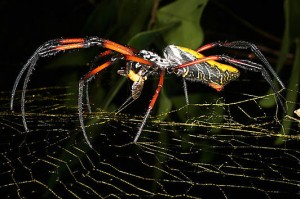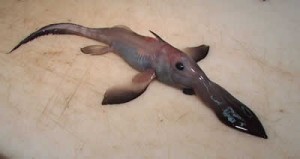Hi! It’s been two weeks since I posted a passion blog because last week I got a library book for my paradigm shift research. So I feel a little out of the loop in my own blog, if that makes sense… and by the way, HAPPY HALLOWEEN! For this blog post, in spirit of my favorite holiday and also because I am feeling pretty spastic this week, there isn’t really a topic of organism, just any organism that I come across that I deem pretty creepy.
So our first scary creature is Neoclinus blanchardi, or the sarcastic fringehead:
This fish is just really kind of weird to me. They live in the Pacific Ocean, off the coast of North America. What makes is scary is that when its mouth is closed, it looks like an old man. But when it opens is parachute-like mouth, it’s pretty horrifying. These are very territorial fish, and when another fish trespasses, the fringehead charges, with its jaws wide open. They can grow to be about a foot long. They are usually brown or grey, but the jaws can be brightly colored, usually yellow. This thing honestly just looks like an alien. But we all know that the ocean can create really terrifying creatures, which is why I have one more fish for this scary post:
This is Macropinna microstoma, the barreleye fish. I’m just going to point out the obvious here: it’s HEAD is TRANSPARENT. It isn’t surprising that these are also called spook fish. They are found in a lot of places in the Atlantic, Pacific, and Indian Oceans. They have skulls of course, but the eyes just aren’t inside of it. They protrude far out, and are tubular shaped. Even weirder: their eyes are oriented straight up, instead of in front of it. The green orbs in the picture are the eyes, not the dents in front. This is so the fish can see silhouettes of its prey against any light above it. They are pretty small, only around 6 inches long. What in all of nature is happening here?
Third is the mata mata, (Chelus fimbriata):
This is a freaky freshwater turtle that lives around South America. I am very conflicted about this animal. Turtles are my favorite animal (alright, tied with wolves), and so I really don’t like that this one is really creepy looking. What is up with its head? It just looks extremely malformed, like it was dumped into toxic waste. There are wrinkles and ridges all over this thing, supposedly to look like bark on a tree, but I think that it is just unfortunately ugly. They only eat fish and invertebrates, and they do this by staying motionless and then just sucking its prey down whole. Oh, and another thing: they have really creepy claws. What is a cute animal doing with claws? Really?
Last for this week is a species of the Gold Orb Web Spider, Nephila komaci:
I am sorry about this, but I really need to add a spider to this scary blog to really make it complete. This, my friends, is the largest known web-spinning spider. Only a couple specimens have been found so far, in Madagascar and South Africa. It was not seen in the wild until 2007. These are red to yellow, with a white patch usually at the top of their abdomen. Its pretty big, about 6 inches across. But what is really impressive (or frightening) is that webs have been found to be over a meter across. Walking into that would be a nightmare. The silk they produce is a pretty golden color. You can rest easy tonight though, this spider is not lethal to humans. So instead to keep you wide awake tonight, just imagine a dozen of these slowly creeping along on your bed in the middle of the night.
Have a fun and safe Halloween!
Best,
Sam

















